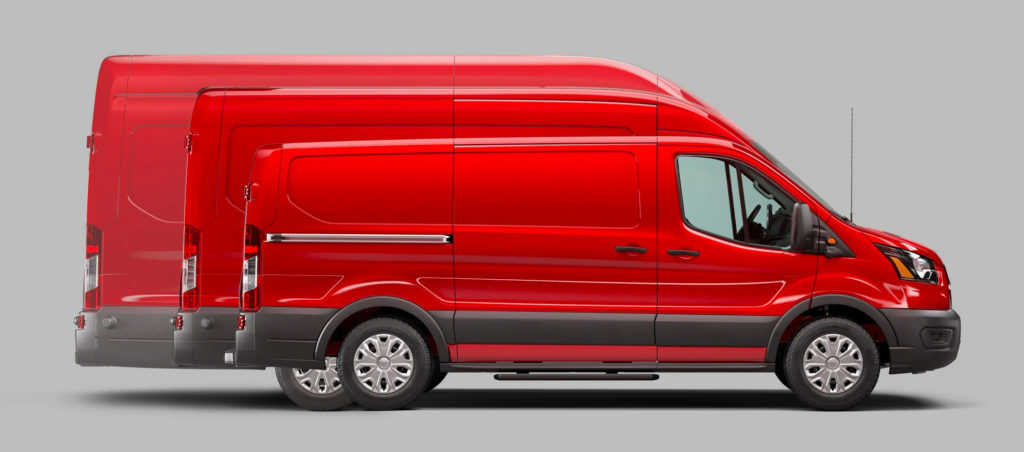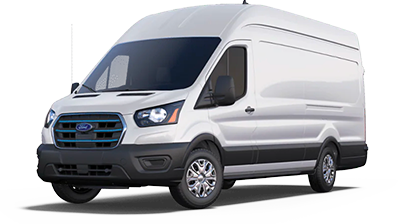What to Know About the Ford E-Transit Work Van

Unless you’ve been hiding in a cave over the past few years, it’s hard to miss the automotive industry’s steady march to electrification. And while EVs from Tesla and other companies dominate the conversation, the revolution is also happening with commercial vehicles, including the Ford E-Transit. As the first mass-produced all-electric work van, the E-Transit makes a compelling alternative to gas-powered offerings.
Here are key factors to understand if you’re considering making the switch.

Configuration
There are no surprises when it comes to E-Transit configurations. Just like the gas-powered Transit, this EV comes in three lengths and three roof heights. There are also chassis cab and cutaway options. But, larger versions come with reduced ranges.

Range
Ford research reveals that the average work van travels 74 miles daily. So, if your business has similar driving statistics, then an E-Transit may make sense. The low-roof Cargo Van version of the E-Transit is rated for 126 miles per charge, but keep in mind that this figure is based on the vehicle operating under ideal conditions. Driving practices, cold weather, and heavy loads can diminish range.

Charging
Using an EV for business involves a change in habits. Periodic stops at the gas station are replaced by daily recharging routines. Using a 240-volt mobile charger, which is included with the van, recharging from zero percent takes about 11 hours (about 10 miles per hour of charge).
An optional Level 2 charging station replenishes the E-Transit at about 15 miles per hour of charge. Commercial charging stations (Level 3/DC fast charging) can boost the E-Transit from 15 percent to 80 percent in about 34 minutes (at a 115 kW recharge rate).
In addition, Ford offers remote monitoring services to keep an eye on range, charging status, and other vehicle conditions.
Maintenance
Without an internal combustion engine, this EV work van requires significantly less service work. Ford estimates that the E-Transit has 40 percent lower scheduled maintenance costs (over eight years/100,000 miles) than its conventional counterpart. About the only thing that requires more attention is the tires. The E-Transit weighs about 10 percent more than the regular work van, so tire replacement may come sooner.
Price
As is typical with most EVs, there’s a premium for ditching an internal combustion engine. The base E-Transit in Cargo Van form starts at around $52,000. That’s a $10,000 premium over the entry-level gas-powered Transit. Federal and state tax credits may offset the difference.

Recharging Costs
Determining recharging costs can be tricky, as utility rates can vary by location or even time of day. So, we’ll rely on a few assumptions to determine a number. According to the U.S. Energy Information Administration, the national average cost for electricity (at a commercial rate) is 12 cents per Kilowatt hour (kWh). The E-Transit comes with a 68 kWh battery.
Multiply $0.12 (the cost per kWh) by 68 (the battery size) to come up with a price of $8.16 to charge an E-Transit battery from empty. This is an oversimplification as other factors (such as charging efficiency) can affect the cost, but we won’t make things too complex for our purposes.
Based on a 126-mile range, some basic math (8.16/126) reveals it costs about 6.5 cents per mile to drive the E-Transit. Remember that Level 3/DC fast chargers will cost more (convenience comes at a price).
In comparison, a gas-powered Transit work van with a fuel economy of 12 MPG (and gas at $4.50 per gallon) costs about 38 cents per mile to operate.
Helpful Links:
Ford E-Transit Technical Specifications (PDF)
U.S. Department of Energy (EV basics and tax credit information)
Ready For Upfitting?
Whether your work van uses gas or electricity, Upfit Supply has all the upgrade gear you need. Contact us today to learn more.





